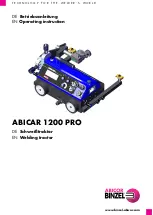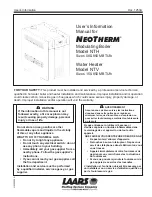
22
Before the wedge welder is used, test welds are to be carried out in accordance with the
welding instructions of the material manufacturer and with national standards or guidelines.
The test welds must be checked.
CAUTION!
The upper drive/pressure roller (16) and the lower drive/pressure roller (17) may run in contact
with one another without welding material.
• The wedge welder temperature must be achieved.
• Insert the wedge welder into the overlapping plastic sheets.
• Use the
“Drive On/Off” key
to switch on the drive.
• Close the
clamping lever (7)
by pressing the
locking clamping lever (10)
. Use your other hand to accomplish
this by holding the automatic welder firmly by the
handle (11)
. Welding wedge is placed in the correct position
automatically.
• Check the position, alignment and welding parameters continuously.
• Use
to guide the automatic welder along the overlap.
• If necessary, brief pressure and subsequent rotation of the
can be used to modify the welding
speed during operation (see Chapter “Speed and temperature setting during welding”).
• Release the
clamping arm (4)
by pressing the
locking clamping lever (10)
and actuating the
clamping lever (7)
1 cm before the end of the welding seam. Use your other hand to accomplish this by holding the automatic welder
firmly by the
handle (11)
. The wedge welder can be extended.
• Switch off the drive motor with the
drive key
by applying brief pressure, and switch off the heating with the
heating key
. The
heating key
must be pressed and held for 1 second. Afterwards an acoustic signal
is sounded and “Heating off” appears briefly on the display.
• Clean the welding wedge of any adhering welding material using the brass brush included in the scope of delivery.
Switch off the wedge welder with the
main switch (2)
and disconnect the
power cord (1)
from
the mains.
Danger of fire and explosion
Hot wedge welding machines can become an ignition source for fire and explosion even when
switched off. Please do not leave/park in the vicinity of flammable materials and explosive gases. The
device should always first be allowed to cool down.
Risk of burning!
Do not touch the welding wedge when it is hot.
Allow the device to cool down. Allow the
welding wedge (5)
to cool down after the welding tasks
are completed.
8.5 Welding process
8.6 Switching off the device














































